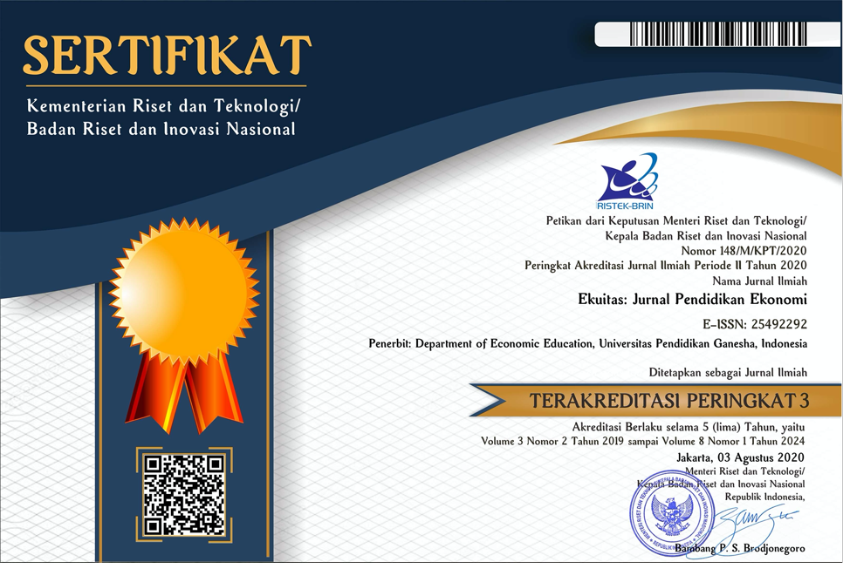Transformasi Model Bisnis pada Industri Kreatif: Studi Kasus Singayu Handmade Jewelry melalui Pendekatan Business Model Canvas
DOI:
https://doi.org/10.23887/ekuitas.v12i1.84509Keywords:
business model transformation, singayu handmade jewelry, business model canvasAbstract
The development of new business models is one of the strategies that can be pursued by creative industries to increase competitiveness and achieve sustainable growth. Singayu Handmade Jewelry is currently facing a number of significant challenges that hinder its growth. One of the main problems faced is the stagnation of sales growth, which is caused by a business model that has not been able to adapt to the changing market dynamics. This study aims to analyze the business model transformation strategy in the creative industry, especially in the Singayu Handmade Jewelry business, through the Business Model Canvas approach. The method used is a qualitative case study with data collection through interviews, observation, and document review. The results showed that Singayu transformed its business model by optimizing the nine component blocks of the business model canvas, such as strengthening and expanding distribution and marketing channels through e-commerce, social media and exhibitions, improving customer relationships through a more personalized approach, adding customization and collaboration services to increase revenue streams, strengthening human resource capabilities, adding key activities to increase brand awareness and sales, increasing cooperation with strategic partners and making efficiency in the cost structure.
References
Alexander, O., & Yves, P. (2010, June). Business Model Generation: A Handbook for Visionaries, Game Changers dan Challangers. In John Wiley & Sons, Inc., Hoboken, New Jersey.
Anggraini, E. D., Sudirman, R., & Fahrurrozi, Moh. (2024). Pengaruh Kualitas Produk, Kualitas Pelayanan, dan Persepsi Harga Terhadap Keputusan Pembelian pada Deli Bakery Banyuwangi. JUDICIOUS, 5(1), 11–25. https://doi.org/10.37010/jdc.v5i1.1445
Coelho, P. S., & Henseler, J. (2012). Creating customer loyalty through service customization. Emerald Publishing Limited, 46(3/4), 331–356. https://doi.org/10.1108/03090561211202503
Dhasmana, A. (2023). Quality Control and Management in Manufacturing Industries: A Critical Analysis. Turkish Online Journal of Qualitative Inquiry (TOJQI). https://doi.org/10.52783/tojqi.v11i3.10012
Fahmi, F. Z., Krismiyaningsih, E., Sagala, S., & Rustiadi, S. (2023). Creative industries and disaster resilience: A focus on arts- and culture-based industries in Indonesia. Elsevier BV, 99, 104136–104136. https://doi.org/10.1016/j.ijdrr.2023.104136
Fibrianti, N., Suprapti, D. D., Ardiansari, A., Isnani, I., & Paramita, N. D. (2022). Targeting MSME Opportunities through Brands: Strengthening the Legal Protection trough Community Services. 5(2), 195–207. https://doi.org/10.15294/jphi.v5i2.60224
Kusumawati, Y. N., & Mulyani, E. (2024). Role of “Business Model Canvas” (BMC) In Improving Omzet, Comparative Analysis Approach of Beginner Enterpreneurs in the Field of Creative Economy. 4(3), 827–834. https://doi.org/10.59188/eduvest.v4i3.1077
Muafi, M., & Hadi, P. (2023). Factors Contributing to Sustainable Growth Performance in Indonesian SMEs: The Role of Business Incubators. International Information and Engineering Technology Association, 18(10), 3297–3308. https://doi.org/10.18280/ijsdp.181029
Natakusuma, D. (2021). Strategi Diferensiasi Produk Event Dalam Manajemen Pemasaran Untuk Menghadapi Pandemi Covid-19. 1(1), 25–33. https://doi.org/10.34013/jett.v1i1.612
Patil-Phd, V., Patil, V. R., & Patil, D. (2023). Impact Assessment of Industrial Exhibitions on The Buying Decision of Customers. 3(3). https://doi.org/10.33140/jerr.03.03.16
Pollmann, K., Janssen, D., Fronemann, N., Velić, M., Bouillé, P., Foucault, B., & Bécam, N. B. (2022). Identifying and Addressing Needs of Heterogeneous User Groups—A Case Study from the Banking Sector. Multidisciplinary Digital Publishing Institute, 6(12), 103–103. https://doi.org/10.3390/mti6120103
Pramitaningrum, E., & Nugraha, D. H. (2023). Market and Industrialization Opportunities of Rumah Unggul Sistem Panel Instan (RUSPIN) Technology Using Business Model Canvas. Industrial Engineering Department Faculty of Industrial Technology Universitas Ahmad Dahlan, 21(1), 52–61.
https://doi.org/10.12928/si.v21i1.58
Pratini, H. B., & Setiawan, I. (2022). Perencanaan Model Bisnis Untuk Merdeka Ritel Dengan Pendekatan Business Model Canvas. 13(2), 163–163. https://doi.org/10.36448/jsit.v13i2.2770
Putri, N. I., Herdiana, Y., Suharya, Y., & Munawar, Z. (2021). Kajian Empiris Pada Transformasi Bisnis Digital. 7(1), 1–15. https://doi.org/10.38204/atrabis.v7i1.600
Ramdani, H. C., Rahayu, S., & Fahmi, R. (2024). Pengaruh Sosial Media Marketing terhadap Minat dan Daya Beli Pelanggan. 22(1), 48–55. https://doi.org/10.33592/pelita.v22i1.2562
Reza, K. M. F., & Noviansyah, K. (2024). STRATEGI BISNIS STARTUP MELALUI BUSINESS MODEL CANVAS: STUDI KASUS GOJEK DAN AIRBNB. 3(5), 1727–1738. https://doi.org/10.53625/jcijurnalcakrawalailmiah.v3i5.7423
Salwin, M., Jacyna-Gołda, I., Krasławski, A., & Waszkiewicz, A. E. (2022). The Use of Business Model Canvas in the Design and Classification of Product-Service Systems Design Methods. Multidisciplinary Digital Publishing Institute, 14(7), 4283–4283. https://doi.org/10.3390/su14074283
Sari, S. R., Arifan, F., Triyono, T., & Niswah, U. (2020). Value Chain Analysis on Handmade Batik Products. State University of Semarang, 13(1), 230–241. https://doi.org/10.15294/jejak.v13i1.21771
Saura, J. R., Palos‐Sánchez, P. R., & Herráez, B. R. (2020). Digital Marketing for Sustainable Growth: Business Models and Online Campaigns Using Sustainable Strategies. Multidisciplinary Digital Publishing Institute, 12(3), 1003–1003. https://doi.org/10.3390/su12031003
Shinde, V. M. (2023). An Implementation on User Centered Website Using Customer Segmentation. International Journal for Research in Applied Science and Engineering Technology (IJRASET), 11(5), 5212–5217. https://doi.org/10.22214/ijraset.2023.52864
Smirnova, À., Zaychenko, I. M., & Bagaeva, I. (2019). Formation of requirements for human resources in the conditions of digital transformation of business. https://doi.org/10.2991/icdtli-19.2019.50
Syafri, M., Shobirin, M. S., Ekowati, D., & Maghfirah, N. (2023). The Impact of Creative Industries on Economic Growth: Case Studies in Developing Countries in Malaysia and Indonesia. 1(10), 271–278. https://doi.org/10.58812/wsjee.v1i10.295
Utami, K. R., Yuliandari, N. K., Nilawati, W., Fahrurrozi, M., Qory, H. I. L. A., Cattleyana,
D., Asyriana, S., & Hakim, A. R. (2023). PENDAMPINGAN DAN PENYULUHAN SUMBER DAYA MANUSIA BERBASIS PELATIHAN SISTEM INFORMASI KEUANGAN DAN ¬ DIGITAL MARKETING (E-COMMERCE) DALAM MENINGKATAKAN PENJUALAN EKONOMI KREATIF DI DESA BULUSARI, BANYUWANGI. 4(2), 369–380. https://doi.org/10.38048/jailcb.v4i2.1674
Yuliana, L., Wijanarko, A. A., Raharjo, A. M., Harnanih, S., & Firdiana, M. (2022). PERANAN INFLUENCER DALAM MENINGKATKAN PENJUALAN PRODUK SELAMA KONDISI PANDEMI. 6(1), 75–88. https://doi.org/10.24123/jbt.v6i1.4874
Yuliati, A., & Huda, S. (2022). Analysis of Influencer’s Influence As Digital Marketing. 2(11), 2288–2294. https://doi.org/10.59188/eduvest.v2i11.643
Zulistiani, & Deanta, J. B. A. (2023). Analisis Pengembangan Bisnis UD. Sinar Harapan Melalui Pendekatan Business Model Canvas. 14(1), 37–43. https://doi.org/10.36982/jiegmk.v14i1.3135
Downloads
Published
Issue
Section
License
Copyright (c) 2024 Moh Fahrurrozi

This work is licensed under a Creative Commons Attribution-ShareAlike 4.0 International License.







